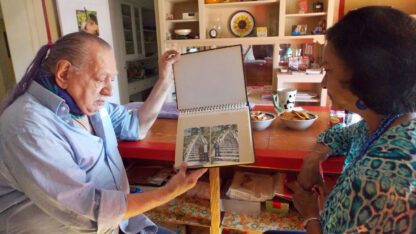The EPA visited Atlanta on Aug. 14 to celebrate investments in transforming a contaminated site into a greenspace and citizen service in the Westside.
EPA Deputy Administrator Janet McCabe and representatives from Atlanta’s regional EPA office started the morning at the Chattahoochee Brick Company site. The EPA is allocating $2 million from the Bipartisan Infrastructure Law to clean up the industrial site and turn it into a park with river access.
Donna Stephens, founder and chair of Descendants of Chattahoochee Brick Company Coalition, has advocated to protect the land from becoming another industrial site and turning it into a memorial and green space.
“There’s not a lot of hope in this area, and to be able to sit on the banks of the Chattahoochee River, take a walk on the path to the plan for this area, take your children out here to have a good time. It means a lot to this community,” Stephens said.
“People are ready for this space,” Stephens said. She said neighbors ask her when the park will open, and that the area is in need of access to the outdoors.
In 2022, with help from The Conservation Fund, the City of Atlanta bought the old brick factory’s land. Right now, it’s a brownfield — an old, unused and contaminated industrial site.
The factory operated around the turn of the 20th century and made bricks. It was owned by former Atlanta mayor and Confederate captain James English. The factory used convict labor, a post-Civil War system where people — mostly Black men, were arrested for little reason or often minor crimes and then forced to work in conditions similar to enslavement.
Former Atlanta Journal-Constitution reporter and author Doug Blackmon wrote about the site in his Pulitzer-winning book “Slavery by Another Name.”
“Thousands of men and some women passed through this place, and they lived there under horrifying circumstances, conditions that are difficult for us to imagine today,” Blackmon said. “Particularly the idea that they were there officially as an action of government, not just of commerce.”
The planned renovation of the space will include a memorial to those who suffered and died at the brick factory and a much-needed green space for the community surrounded by industrial facilities.
The $2 million from the EPA is speeding up the work. McCabe said the Bipartisan Infrastructure Law made it easier for the EPA to pump more money into existing programs, like the Brownfield Program, with long wait lists.
“What’s great about the Brownfields Program is that there’s thousands of sites across the country that are ready to go or virtually ready to go, and all they needed was money,” McCabe said.
These locations are anything from large industrial sites like Chattahoochee Brick Co. to smaller ones, like laundromats, that tend to leave legacy contamination behind.
According to City of Atlanta officials, a contractor has been selected, and it will be about 18 months before equipment is on the ground cleaning up the site.
After visiting the Chattahoochee Brick Company, the EPA headed to English Avenue to visit Historic Westside Gardens.
Volunteers and Historic Westside Gardens employees were prepping the garden for a market that happens every Friday.
Rosario Hernandez stood shoulder to shoulder with her team—gardeners clad in green T-shirts sprawled with the Historic Westside Gardens logo. She said this English Avenue garden isn’t their only location, and with a mobile market, garden projects at senior centers, other gardens and farms, and composting programs, Historic Westside Gardens is a busy network.
What Hernandez didn’t know was that the EPA wasn’t visiting just to look at an urban garden — they were there to celebrate her.
“Our office of land and emergency response has something they call the Citizen Excellence in Community Involvement Award,” McCabe said. “It’s a national award. I think there’s only one given every year.”
Because Hernandez isn’t just growing produce — she has played a central role in the EPA’s efforts to clean up westside Atlanta neighborhoods from lead contamination in the soil.
McCabe said Hernandez served as a liaison between the EPA and the community to get information out, respond to questions, and be a stalwart advocate for her neighbors’ health and environmental wellbeing.
Hernandez worked with an Emory researcher who found lead in her and other properties in English Avenue and Vine City. Afterward, she brought a soil sample from her yard to the EPA at a local science fair.
“And the guy said, ‘where’d you get this from?’ and I was like, ‘it’s all over my yard, it’s all over the side, it’s all over across the street,’” Hernandez said. “And he said, ‘that’s slag, and that’s where the lead is coming from.’”
Lead is a major health hazard, particularly to young children.
So, the EPA started studying the extent of the contamination and came up with a clean-up strategy.
Hernandez was the first resident who allowed the EPA to dig up her property and remove the lead.
“And I believed they would do the right thing … but the neighborhood did not. Because it’s the federal government and they think you’re here to take everything,” she said.
She said it was really hard — she lost her garden and her daughter’s garden in the process.
“The community is cleaner because of the work that was done,” Hernandez said.
Hernandez said it was initially difficult to get more neighbors on board with the EPA’s plan to remove lead from properties. This intensive process requires digging up feet of dirt around peoples’ houses.
She said the EPA promised her property would look even better than before, and she said they delivered. They did such a good job that other people started inquiring about having their yards cleaned up.
“You do things because you’re supposed to do them, it’s the right thing,” Hernandez said.
And that soil is important—it’s key to environmental health and the gardens she helps run, a network working to improve healthy produce access in west Atlanta.









